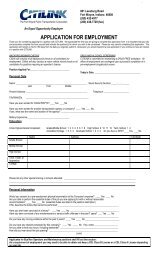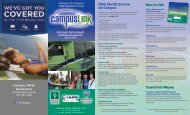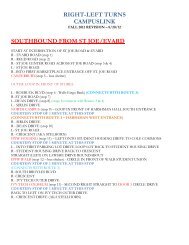Final Report 3-5 - Citilink
Final Report 3-5 - Citilink
Final Report 3-5 - Citilink
Create successful ePaper yourself
Turn your PDF publications into a flip-book with our unique Google optimized e-Paper software.
Transit Development Plan –<strong>Final</strong> <strong>Report</strong>CHAPTER FIVESERVICE STANDARDS<strong>Citilink</strong> provides fixed route and ADA paratransit service within the City of Fort Wayne andadjacent areas. This chapter is intended to provide guidance for <strong>Citilink</strong> to review itsperformance indicators and service standards. These standards are utilized as a guide in thisstudy to analyze routes and services. They can also serve as a recommendation to <strong>Citilink</strong> forstandards that will improve upon what is already being utilized by the agency.The <strong>Citilink</strong> route structure is intended to address transportation needs resulting from a disperseddevelopment pattern with a multi-centered regional transit system that includes connectionsbetween neighborhoods and communities within the City. <strong>Citilink</strong> also provides paratransitservice for disabled persons who are unable to use fixed route service. These service factorscreate the need for standards that address various service delivery methods and provide guidanceon a number of factors for the agency.5.1 Overall Fixed Route DesignThis section provides standards for basic route structure for <strong>Citilink</strong>. These provide a basis forthe service standards in the following sections and represent an important element of overallservice analysis. The <strong>Citilink</strong> fixed route system should have elements that are consistentthroughout the system. This consistency is important for the public to understand how thesystem can be used. The following are basic parameters of the design of the system.• Routes should be separated into functional categories. The level of service on individualroutes will vary by its function.• <strong>Citilink</strong> routes should be divided into three categories for the purpose of determiningroute design and performance standards. These are Radial routes, Crosstown routes, andRoute Deviation services.• Routes should be predominantly bi-directional in nature. Large one-way loops should beavoided if possible.• Travel times between major destinations should be minimized by providing some routesthat operate on the fastest and most direct route, and by scheduling timed transfersbetween routes to minimize wait times. Layover or scheduled recovery time should onlybe provided at route termini.The proposed Service Standards follow these general guidelines. They provide a tool for theguidance of those responsible for planning and operating the <strong>Citilink</strong> system, and can be used toevaluate performance once the routes comprising this system are in operation. In some cases, alldesign and performance standards may not be met because of cost, personnel, equipment, orother constraints. Every effort should be made to provide service that is in conformance withthese standards. The process of identifying routes or portions of routes that either exceed or donot reach these standards should be used to guide decisions in response to decreases or increasesin funding for <strong>Citilink</strong> service.Fort Wayne - <strong>Citilink</strong> Page 84
Transit Development Plan –<strong>Final</strong> <strong>Report</strong>5.2 Route and Schedule Design StandardsThe following standards provide an overview of route and schedule design, including standardsfor many elements of <strong>Citilink</strong> service. These standards were utilized as a basic guide for routeand schedule design for the <strong>Citilink</strong> system.Operating Environment<strong>Citilink</strong> routes should operate primarily along major arterials. It should also run on someresidential collector streets that are suitable for operation of <strong>Citilink</strong> buses, and in some casesinterstate highways. Because of the need to minimize the impact of buses in residential areas,the use of smaller sized buses will be considered on certain routes that circulate throughresidential areas.Service AreaService coverage should be defined as the area within 1/3 mile walking distance of the nearestbus stop. <strong>Citilink</strong> shall serve to the extent feasible, all major employers, hospitals, schools, andpublic housing within the City of Fort Wayne.Passenger StopsIn order to provide a safe environment for passenger boarding and alighting, <strong>Citilink</strong> shouldadopt a policy of formally designating bus stop locations. All bus stops will be designated andhave signs indicating their location. Efforts will be made to include route and scheduleinformation at bus stops. The spacing of bus stops will vary by location, but as a general rule,there should be 7 to 8 bus stops per mile in downtown Fort Wayne, and 3 to 6 bus stops per milein other locations.Route SpacingThe distance between routes will be guided by the population density and automobile availabilityaccording to the standards in the table below.Density (Persons Per Square Mile)Automobiles Over 2,501 to 1,000 to UnderPER HOUSEHOLD 5,000 5,000 2,500 1,000Under 0.40 1/4 mile 1/4 mile 3/8 mile ½ mile0.40-0.80 1/4 mile 3/8 mile ½ mile 1 mile0.81-1.50 3/8 miles ½ mile 1 mile *1.51-2.00 ½ mile ½ mile * *Over 2.00 1 mile * * *Fort Wayne - <strong>Citilink</strong> Page 85
Transit Development Plan –<strong>Final</strong> <strong>Report</strong>Hours of OperationThe hours of operation should be based on demand and relate to the route’s function. Themaximum span of service is from 5:30 a.m. to 9:00 p.m. on weekdays, and from 7:00 a.m. to7:00 p.m. on Saturdays.Service LevelsService levels for each route should be based on demand. To foster a systematic approach, twolevels of service are defined for different operating time periods. The service level should beconsistent through each time period.Peak service is generally between the hours of 6:00 a.m. and 9:00 a.m., and between 3:00 p.m.and 6:00 p.m.Off-peak service is provided at all other times including the mid-day period between 9:00 a.m.and 3:00 p.m. and in the evenings and weekends.Every effort should be made to provide coverage throughout most of the service area during theoff-peak service periods. But since lower ridership is experience during these times, a reducednumber of routes may be operated.Frequency of ServiceThe route’s frequency should correspond to demand. Some routes may only operate during theweekday peak period while others may run at all times with relatively high frequencies.Maximum policy headways for Radial, Crosstown, and Connector routes are below.MAXIMUM HEADWAYS BY TIME PERIODPeakOff-Peak30 minutes 60 minutesThese maximum headways in the off-peak periods should not be exceeded if the route is to beoperated. The maximum peak period standard of 30 minutes should only be implemented ifsufficient ridership and funding exists. Headways should conform to regularly recurring clockintervals. Currently, all but two of the routes in the system operate on 60-minute headwaysthroughout the service day. This will need to be addressed through the service design plan.Transfers and Timed TransfersScheduled arrival and departure times for <strong>Citilink</strong> routes having common transfer points shouldbe coordinated to the maximum extent feasible. Dwell time should be avoided on trunklineroutes for mid-route transfer points. Routes should be designed to link in patterns that areconsistent with consumer needs and desires, but also meet acceptable travel times.Fort Wayne - <strong>Citilink</strong> Page 86
Transit Development Plan –<strong>Final</strong> <strong>Report</strong>Free transfers are provided by <strong>Citilink</strong> drivers upon request by passengers when boarding buses.The main transfer location is Superior Transit Facility. Transfers are accepted at other locationswhere routes intersect. The transfer ticket is only valid on the next scheduled trip to which thepassenger is transferring. Transfers cannot be used for return trips.LayoverThe amount allocated for layover time will be a minimum of 7 percent of the total cycle time.Additional layover time may be provided as necessary to achieve clock headways. Layovershould be avoided at locations where through passengers are expected. This includes mid-routelocations and along one-way loops.Loading StandardMaximum loading standards ensure that most passengers will have a seat for at least the majorityof their trip. The maximum average load factor is calculated by dividing the total number ofpassengers passing the maximum load point by the number of seats passing the maximum loadpoint during the operating period being considered. Since this is an average, individual trips mayexceed the standard. The loading standard for <strong>Citilink</strong> routes should be a maximum average loadfactor of 1.2 during the weekday peak periods, and 1.0 at all other time periods. For individualtrips, this should not be exceeded for time periods greater than 15 minutes.5.3 Passenger Amenities and InformationPassengers amenities and information are an important part of the service standards review of atransit network. These facets of <strong>Citilink</strong> operation relate to the user-friendly nature of the serviceprovided. This is an important element of a transit network as a public service.Bus Shelters and BenchesBus stops with more than 25 passengers boarding on a daily basis should have a bus shelter.Benches should be provided at bus stops with more than 15 passengers per day.In addition, since a large percentage of <strong>Citilink</strong> passengers transfer, passenger amenities shouldbe provided at all major transfer locations. Special facilities may be provided, if necessary, athospitals and clinics. These key bus stops should have bus shelters or other means of weatherprotection for passengers. Schedule information for all routes should be displayed or available topassengers.Public Timetable AvailabilityRoute and Schedule brochures will be available upon request from bus drivers and from <strong>Citilink</strong>office clerks. They will also be displayed and made available at the Superior Transit Facility anda number of other employment and activity centers throughout the City as determinedappropriate by <strong>Citilink</strong> staff.Fort Wayne - <strong>Citilink</strong> Page 87
Transit Development Plan –<strong>Final</strong> <strong>Report</strong>Bus Color and LogoFor easy identification of <strong>Citilink</strong> services, a <strong>Citilink</strong> color scheme and logo will be designed andupdated from time to time. This will be used consistently on <strong>Citilink</strong> buses, letterheads, tickets,bus stop signs, and other printed materials or objects. The current logo and bus color are recentand were developed as part of an effort to “re-brand” the system. These colors and the logoshould be maintained at the present time.Vehicle Identification SignIdentification signs will display the route the bus is traveling on at all times. When routes areinterlined at the Superior Facility, the signs will be changed upon entering the downtown areaand before reaching the Superior Facility.Vehicle AccessibilityAll <strong>Citilink</strong> vehicles should be lift equipped and all <strong>Citilink</strong> vehicles and facilities will beaccessible to disabled persons as required by the Americans with Disabilities Act.5.4 Performance StandardsThese standards are intended to review the performance of each route and service in the system.Performance standards have generally been separated into route categories to provide separatestandards by route function. It is important for <strong>Citilink</strong>, its board, and local decision-makers tounderstand that all routes cannot be expected to operate with the same efficiency. Thesestandards are presented as an effort to classify routes for performance evaluation.Passenger Productivity<strong>Citilink</strong> should regularly evaluate the performance of individual bus routes based upon therevenue to cost ratio, passengers per revenue hour and passengers per revenue mile. It willassure that each route performs at a rate equal to at least 50% of the systemwide average for thattransit mode. Other performance standards, such as on-time performance, should also bemonitored.Standards for individual route productivity should be based on actual experience. Thoseperforming marginal or unsatisfactory will be scrutinized for ways to improve productivity.Routes significantly exceeding the “good” standard will be considered for improved service.Different standards for the different route categories are created. These standards, which arebased on the September 2002 <strong>Citilink</strong> passenger count, are listed below.Fort Wayne - <strong>Citilink</strong> Page 88
Transit Development Plan –<strong>Final</strong> <strong>Report</strong>RADIAL ROUTESCategory Passengers/Revenue HourPassengers/Revenue MileFareboxRecovery RateGood >20 >1.5 >15%Satisfactory 15-20 1.0-1.5 10-15%Marginal 10-15 0.7-1.0 5-10%Unsatisfactory 10%Satisfactory 10-15 0.7-1.2 7-10%Marginal 7-10 0.4-0.7 4-7%Unsatisfactory 8%Satisfactory 7-10 0.6-1.0 5-8%Marginal 4-7 0.3-0.6 3-5%Unsatisfactory
Transit Development Plan –<strong>Final</strong> <strong>Report</strong>should show the actual productivity measures for that particular month and be the basis of an ongoingevaluation of individual <strong>Citilink</strong> bus routes.Route evaluation should follow a two-step process. The first step is to identify how each routeperforms in terms of ridership and cost effectiveness compared with the performance standards.Once this screening process is completed, the second step is a detailed evaluation of each routethat is either not performing up to standard or is performing well above average. These routescould be subject to a number of actions including frequency reduction, service span revision,realignment, rescheduling, route consolidation or other restructuring, extensive marketingefforts, or elimination.The first step in the screening process should include all performance indicators but should focuson passengers per revenue hour, passengers per revenue mile, and the farebox recovery rate. Thenumbers of passengers per hour and per revenue mile are measures of system effectiveness. Theexpense recovery rate provides an indicator of the cost efficiency of each route, and provides onemeasure of the adequacy of the fare structure.The period of time that performance indicators are calculated will relate to internal and externalreporting requirements. Typically, they should be compiled on a monthly basis. Comparisonswith the previous month, the same month for the previous year, and with a two or three yearrunning average should be included to identify trends.The performance achieved by <strong>Citilink</strong> routes should be used to modify the performancestandards. For example, routes categorized as “good” can be those that exceed 125 percent ofthe system average for the particular measure. Acceptable routes are those falling between 75and 125 percent of the system average. Marginal routes are between 50 and 75 percent of thesystem average, while unacceptable routes are below 50 percent of the system average. Routesthat fall in the unacceptable category in two of the three principle measures will be subject to adetailed analysis.Unacceptable routes should receive a more detailed analysis in step two. At this level in theperformance evaluation process, a route’s performance in all standards is analyzed. This detailedevaluation should examine performance by time period, day of week, and route segment. Avariety of measures should be considered for action including redesign, schedule reduction,schedule increase, marketing activity, and other actions.Each route should be reviewed annually. Routes should be reviewed more often if ridershiptrends are negative, special requests for service are received, or other special circumstances arenoted. The evaluation process should also include routes with good performance. These shouldbe candidates for more frequent service or some other kind of service increase.New ServicesNewly established transit routes, after having operated for two years, should operate withperformance standards at no less than 50% of the systemwide average in two of the threecategories for its functional category. If a newly established transit route or service fails toFort Wayne - <strong>Citilink</strong> Page 90
Transit Development Plan –<strong>Final</strong> <strong>Report</strong>operate at the specified level for three consecutive months, following the initial two year period,then <strong>Citilink</strong> should evaluate alternative means to achieve the productivity standard or the routeshall be terminated.Service Expansion PolicyImprovements to and expansion of the <strong>Citilink</strong> system should be based on the <strong>Citilink</strong> TransitDevelopment Plan.Fort Wayne - <strong>Citilink</strong> Page 91









